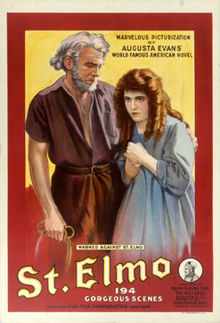St. Elmo (1914 film)
| St. Elmo | |
|---|---|

Theatrical release poster
|
|
| Directed by |
|
| Produced by | William Fox |
| Written by | William Jossey |
| Based on |
St. Elmo by Augusta Jane Evans |
| Starring |
|
|
Production
company |
|
| Distributed by | Box Office Attractions Company |
|
Release date
|
|
|
Running time
|
6 reels |
| Country | United States |
| Language | Silent (English intertitles) |
St. Elmo is a 1914 American silent drama film produced by the Balboa Amusement Producing Company and distributed by William Fox's Box Office Attractions Company. It was the first feature-length film adaptation of Augusta Jane Evans's 1866 novel of the same name. The story follows the life of the title character (played by William Jossey), who kills his cousin (Francis McDonald) over the love of Agnes (Madeline Pardee), falls from grace, and eventually finds redemption and love with Edna (Gypsy Abbott). It is disputed who directed the film; many sources credit Bertram Bracken, while others list St. Elmo as J. Gordon Edwards's directorial debut.
Some reviewers praised the scenery and overall production quality, considering the film an improvement over staged adaptations of the novels. Others found the scenery irrelevant and the story confusing. Despite mixed reviews, the film was financially successful, reportedly setting box office records. The following year, a film adaptation of an unrelated Evans novel, Beulah, was marketed as a sequel. As with most Balboa films, St. Elmo is now believed lost.
St. Elmo Murray and Murray Hammond, his cousin and best friend, are both in love with a young woman named Agnes Hunt. Although Agnes loves Murray, she rejects him for being too poor. Instead, she accepts the wealthy St. Elmo's marriage proposal. St. Elmo's mother holds a ball to celebrate the engagement. After the betrothal is publicly announced, Murray and Agnes meet covertly in the gardens. St. Elmo discovers their affair, challenges Murray to a duel, and kills his cousin with the first shot. The Devil possesses St. Elmo, and he becomes a cruel wanderer, spreading misery and misfortune where he travels.
Twenty years later, the Edna Earle is traveling by train, hoping to find employment in a cotton mill after the death of her father, the village blacksmith. The train derails, and St. Elmo saves her from the burning wreckage. This act sets St. Elmo on the path to salvation as he and Edna slowly fall in love. Initially planning to depart for distant lands, a vision of Christ leads him to aid the impoverished. Freed from the Devil, he becomes a minister and marries Edna.
...
Wikipedia
